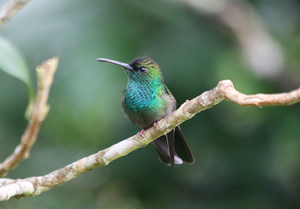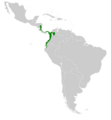Blue-chested hummingbird facts for kids
Quick facts for kids Blue-chested hummingbird |
|
|---|---|
 |
|
| Conservation status | |
| Scientific classification | |
| Genus: |
Polyerata
|
| Species: |
amabilis
|
 |
|
The blue-chested hummingbird (Polyerata amabilis) is a tiny, colorful bird. It belongs to the hummingbird family, called Trochilidae. You can find this amazing bird in countries like Colombia, Costa Rica, Ecuador, Nicaragua, and Panama. It likes to live in warm, wet habitats such as lowland forests. It can also be found in areas where forests used to be.
Contents
What Does the Blue-Chested Hummingbird Eat?
This hummingbird is a busy eater! It mostly sips nectar from flowers. It also catches small insects. It finds these insects by looking closely at leaves.
How Do They Find Food?
Blue-chested hummingbirds have a special way of finding food. They often fly a regular path between flowers. This is like following a map to all their favorite feeding spots. They also protect their feeding areas. This is especially true if there are not many flowers around. These feeding spots are often at the edge of forests.
Where Do Blue-Chested Hummingbirds Live?
These birds live in several countries in Central and South America. They prefer warm, tropical places.
What Kind of Habitat Do They Like?
They love subtropical or tropical moist lowland forests. These are forests that are warm and get a lot of rain. They can also live in areas where forests have been cut down. This shows they can adapt to some changes in their environment.
What is Special About Their Name?
The scientific name for this hummingbird is Polyerata amabilis. Scientists sometimes change how they classify animals. This helps them understand how different species are related.
Why Did Their Scientific Name Change?
This hummingbird used to be in a different group called Amazilia. But in 2014, scientists did a new study. They found that the old group was not quite right. So, they moved the blue-chested hummingbird to a different, older group called Polyerata. This helps keep bird families organized correctly.
Images for kids




